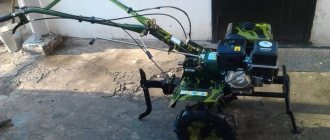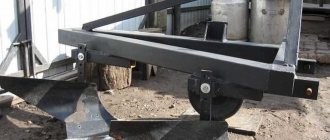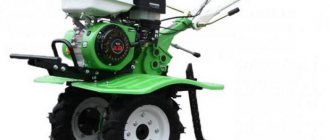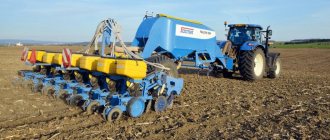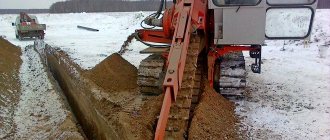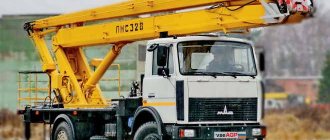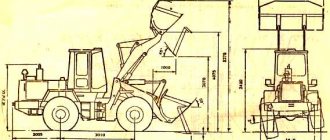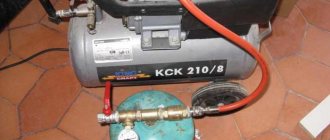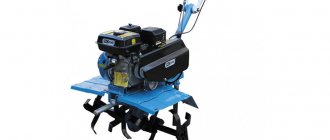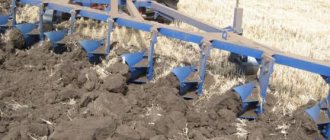Good day, dear readers, we recently did a review article on the topic of plowing the land, then we touched on the topic of how to choose a plow for a walk-behind tractor, but today we have a similar topic.
First of all, let's define what Chisel tillage is - this is the process of loosening the soil without directly turning it over. The process itself occurs in such a way that the soil is removed from the monolith, without creating a “plow sole”. Why is this work being done? With this, moisture can easily penetrate deep into the soil. One of the determining factors of such processing is its depth. Based on this, chisels are processed with the following units: cultivators, plows, deep rippers. If you want to increase the productivity of the field where you grow crops, then this technology will definitely help you with this. Of course, if you follow all the nuances and also select the right and functional unit for this.
Design advantages
The swath width when using this tool can reach up to 12 meters. Such plows are equipped with spring-loaded struts. Therefore, when using this tool, vibrations are created, providing additional loosening of the soil. Since each chisel plow stand is mounted on shock absorbers, among other things, the possibility of equipment breakdown, for example, in the event of an accidental collision with an obstacle, is eliminated.
Most inverter models are complemented by a special toothed or tubular roller. These plow design elements are intended to break up large lumps remaining after plowing and to level the field surface. Do not cultivate the soil too deep with the roller - about 20 cm. If the plow is not initially equipped with it, it can be purchased separately.
Advantages of use
When using a tool such as a chisel plow, you can get the following advantages:
- reduction in labor costs by an average of 17%;
- increase in yield up to 30%;
- reasonable cost.
Most often, a plow of this design is used for annual scheduled plowing using classical technology for cultivating agricultural crops. But it can also be used to combat soil compaction. In the latter case, cultivation of the land with this tool is carried out approximately once every 3-5 years or once per crop rotation. The annual use of this tool on neglected fields with highly compacted soil leads to a significant improvement in the quality of the latter. The soil becomes loose, moisture- and water-permeable after three years of using the IF.
The chisel plow can penetrate very deeply into the soil. Moreover, after its use, plant residues from the previous harvest remain on the surface. This ensures the formation of a large amount of humus. In addition, the straw blanket covering the field further prevents the soil from drying out and protects it from wind and solar erosion.
When using simple reversible plows, a compacted layer is formed in the soil at the border of the arable and subsurface layers, retaining water. This leads to the fact that even with a general moisture deficit, its runoff from the fields increases significantly. A cushion forms over several years under the weight of conventional plows. When using IF, since in this case the loosening occurs very deeply, this compaction is destroyed very quickly (in some types of soil it goes much deeper). This feature, of course, can also be attributed to the advantages of chisel plows.
Chisel plow: device, features and principle of operation
A chisel plow is specialized agricultural equipment for deep, non-moldboard plowing of the soil, which further deepens the arable horizon. The purpose of a chisel plow is determined by its versatility, that is, the ability to simultaneously perform the following useful operations while loosening the soil:
- cutting weeds;
- cutting turf and laying mineral fertilizers;
- stubble peeling and much more.
Operation of chisel units is possible with tractors of the 3-4t class. and engine power from 80 to 500 hp, for example, MTZ 1523.3, MTZ K 3160 ATM, John Deere 7730, New Holland TM 140, etc.
The advantages of a chisel plow are its high productivity, speed and quality of work. The chisel plow is indispensable where high-quality deep and medium-deep plowing of the soil with the formation of an even surface is required. Plows of this class can be used for work on large farmlands.
They are excellent for plowing the soil in the autumn, as they provide the best soil drainage, prevent stagnation of water, and improve conditions for the creation of the root system. In addition, when plowing without moldboard, plant residues do not turn over along with the ground, but cover the surface in an even layer, which is impossible to achieve when plowing with a conventional plow. By rotting, the plants become a natural fertilizer for the soil, which helps increase productivity.
CONSTRUCTION AND FEATURES OF THE CHISEL PLOW
A chisel plow consists of a frame, a vertical stand, couplings (upper ones for connecting to the tractor and lower ones for attaching working parts), a support roller, traction, a support wheel, travel limiters, racks and tips attached to them. The frame is a welded, non-demountable structure, which gives the plow special rigidity and stability during operation.
Frames can be one, two or three beams. Some three-bar chisel plows have a folding design, which is achieved thanks to remote hydraulic cylinders. The working parts of chisel equipment are dismountable, which allows you to quickly and timely replace a faulty part and does not require the purchase of a new tool.
Nominally, chisel units can be divided into three subtypes: cultivators, plows and subsoilers. However, in fact, manufacturers do not make any difference between them and classify them as one type of plow. Meanwhile, this classification is based on one of the key characteristics, namely grip depth.
Chisel cultivators carry out moldboard-free flashing at a depth of up to 30 cm. The plows themselves work at a depth of 30-45 cm, which is necessary to decompact the subsoil horizon. In turn, deep-slit rippers have a working depth of over 45 cm. It is worth noting that the purchase of equipment for working at a depth of more than 30 cm is justified only in cases where plowing will be carried out in particularly dry areas with high rates of water and air soil erosion.
The most common subtype on the market - chisel cultivators - are distinguished by a fairly reasonable price, excellent operating speed (6-8 km/h) and have a working approach width of up to 8 m. Chisel cultivators are equipped with spring-loaded stands to create additional vibrations of the working bodies in the soil, and also with equipment for loosening and thoroughly breaking up the resulting lumps: reverse compaction rollers, a tooth roller (one or two rows), a spiegel harrow. The use of additional equipment makes it possible to make the canvas as uniform as possible, for example, when using a loosening and compacting roller, the soil is broken into clods of no more than 5 cm.
CHARACTERISTICS AND OPERATING PRINCIPLE OF CHISEL PLOWS
Technically, chisel plows are characterized by such indicators as depth and grip (which was already mentioned earlier), width of a single pass (from 2 to 12 m), productivity (up to 2 hectares/hour) and operating speed (up to 10 km/hour) . A distinctive feature of chisel technology is its low energy intensity, only 3-6 kW per working element.
The principle of operation of moldless chisel plows is as follows: stands with working parts cut the soil below the soil layer and loosen it. Weeds and plant remains are caught on the posts and carried to the surface, covering the ground in an even layer. With a deep flash, a small ridge forms at the bottom of the furrow.
Currently, the market offers chisel plows of French, German, English, American and Russian production. Moreover, we can say with confidence that domestically produced plows are practically in no way inferior to their foreign counterparts. The price range for chisel units is quite large: from 199,000 to 1,500,000 rubles. The price depends on the configuration and operating parameters of the equipment.
Scope of use
PCH plows are used mainly in fallow fields (including on slopes) when cultivating grain crops. They can be used on any soil, except rocky, in all agroclimatic zones. It is also possible to plow using such a plow on soils subject to wind and water erosion.
In addition to grain fields, the chisel plow can be used for deep soil cultivation in orchards and vineyards (in the inter-row spaces). Also, this attachment is often used to rejuvenate meadows and pastures or to improve the drainage properties of the soil.
Types of chisel plows
There are several models of IF plows. Structurally, they are practically no different. The difference is mainly in the width of the swath. You can find out exactly what technical characteristics a particular model has from the table below.
| Model | Working width (m) | Maximum speed (km/h) | Number of working bodies (pcs) | Maximum processing depth (cm) | Productivity (ha/h) | Required power (l/s) | Weight (kg) |
| PCH-2 | 2.3 | 10 | 4 | 45 | 2.3 | 150 | 600 |
| PCH-3 | 3.2 | 6 | 3.2 | 250 | 850 | ||
| PCH-4 | 4.5 | 8 | 4.5 | 350 | 1100 |
Models PCH-2,3 and 4 are most often used in agriculture. However, more productive chisel plows can be used for soil cultivation. The working width of some models can be 12 m. But their plowing depth is usually less - 23-25 cm.
Chisel plow, what is it and why is it used?
As we found out earlier, technologies for such soil cultivation significantly increase the yield and quality of the land; not every plowing has a positive effect. The chisel plow allows you to carry out the process of loosening and saturating the soil with oxygen, moisture, and mineral elements, without damaging the upper, fertile sphere. It is the IF that protects the soil from erosion, water and wind.
The inverter is equipped with a loose ridged bottom, thanks to which it can easily
Let's find out what the most popular models exist, then we provide you with this list: PLN-5-35, PCH-(4+1)-50M, PCH-4.5, Chip, PCH-10.01, PCH-6, PCH- 2.5.
They are hitched to tractors and the processing process takes place, while only up to 89% of their capacity is used.
One of the main indicators of the efficiency of the unit is the width of tillage. It usually ranges from 3-7 meters, depending on the manufacturer and price. And the depth of the cultivated soil reaches 44-46 cm. Also, many chisel plows are equipped with special mounted rollers, which allow you to additionally loosen the soil by 10 cm and level it. To protect the device from excess load, special shear bolts are attached to the body. The racks have a design that allows the unit to process soil of varying composition with pressure up to 1.4 kg/sq. cm, humidity up to 29-31%, and hardness up to 39-46 kg/cm2. This does not apply to lands with a lot of stones in the ground. Let us remind you, or let you know (if you have not heard this before), that you need to cultivate the soil at a depth of 41-46 cm every 3 years, and in this case, a chisel plow is perfect.
Review of the PCh-2.5 chisel plow on the T-150K tractor
Manufacturers
Most often, Russian farmers use domestically produced chisel plows, since they are cheaper than imported ones. In our country, many inverters are produced by Rostelmash, BDT-Agro LLC and others. However, the most popular are plows made. The products of this company are supplied to the market under the Almaz brand. The advantages of the inverter from this manufacturer include:
- strength and reliability of the structure;
- automatic cleaning of rollers during plowing;
- ease of repair, etc.
Sometimes, of course, imported chisel plows are also used on domestic fields. For example, Lemken brand implements have received very good reviews from farmers. The plows of this German manufacturer are distinguished by excellent build quality, high productivity and ease of use. But they, of course, cost more than domestic ones.
Scientific justification for the need for the chisel method of tillage
Science has long proven that plowing the soil is not always as effective as it should be and brings results. The design of tools to perform this process requires improvement and many modifications. The purchase of a PC will allow the farmer to resolve many issues related to proper soil cultivation. Thanks to this unit, the soil becomes filled with moisture and nutrients. Also, after the inverter there are no combs or cambers left. The very concept of “chisel” is of English origin. Translated, it means a plow for plowing land without moldboards.
In order not to harm the upper fertile ball of soil and to process it with less energy intensity and labor costs, it is necessary to use only a chisel plow. This device is produced by manufacturers of agricultural machinery of various modifications. The main ones are PLN and IF. They are easily coupled with many models of tractors, such as K-744, K-701, T-150 and of course MTZ.
What tractors is it used with?
According to the manufacturers' recommendations, a chisel plow, which plows to a depth of up to 45 cm, can be mounted on equipment with a power of at least 150 l/s. Therefore, such models are most often used with tractors T-150, MTZ 1523, 1822, 2022, etc.
Of course, you can also use a chisel plow on less powerful equipment. MTZ 1221 “Belarus” (130 l/s), for example, copes with it very well. However, in this case, an inverter is mounted on the tractor, plowing to a depth of no more than 23-25 cm with a working width of 2.4-2.6 m. Chisel plows can also be cushioned with HTZ-150K-09, VT-150D, New Holland TM 140 ", "John Deere 7730" and almost any other models of tractors with a capacity of 80 l/s or more, domestic or imported.
Advantages of the Tektonik subsoiler plow produced by Kubanzheldormash
- The powerful and reinforced gun frame has a 25% safety margin, which is achieved by correct engineering calculations of pipe cross-sections and the use of high-quality low-alloy steel 09G2S. Pipe cross-section - 150*100 with a wall thickness of 8 mm
- The design of the Tektonik deep-ripper plow is designed and manufactured in such a way as to minimize the force and vibration load on traction equipment units
- Simple and convenient adjustment of tillage depth
- Working parts of the subsoiler produced by "BELLOTA"
- Tillage depth up to 45 cm
- Protection of the rack from deformation and fracture using a “shear bolt”
- The spur roller effectively breaks up soil clods, levels and compacts the soil
- High quality painting of the entire structure, individual components and assemblies, which is achieved through the preparation of painted surfaces by shot blasting, as well as careful adherence to drying conditions
Brief instructions for operating a chisel plow
Plowing using an inverter is quite easy. Before starting work, the tractor driver only needs to release the control lever to the free position. As a result, the plow will fall to the ground under its own weight. When plowing, the working body of the inverter additionally rests on the wheels. In some cases, the latter are made of metal. But most often, IF plows are supplemented with conventional support wheels with a tire and a tube. Their position, among other things, determines the depth of plowing. According to the instructions, turning at the end of the furrow should only be done after the plow has been moved to the transport position.
Chisel moldboard plow: tests, advantages, efficiency
Equipment May 25, 2017
Text: D. A. Petukhov, head. laboratory; S. A. Sviridova, leading scientific coll.; E. V. Bondarenko, scientific. co-workers, Novokubansk branch of the Federal State Budgetary Institution "Rosinformagrotech"
A scientific approach to soil cultivation and a competent selection of suitable units can significantly save energy, labor and time resources. In this regard, comparative analysis, operational-technological, agrotechnical and economic assessments of chisel and chisel-moldboard plows are very relevant.
Tillage is the most energy-intensive operation in crop cultivation technology, since it consumes up to 40 percent of all fuel consumed in agriculture. Reducing energy costs and high-quality results can be ensured only if the basic principles are observed: choosing the optimal method of cultivating land, improving the designs of tillage machines and their working parts, as well as optimizing their modes.
SYSTEMATIZE DATA
Chisel processing, or chisel treatment, is a non-mouldboard loosening, crumbling of arable and subarable horizons without turning over the formation. Chisel loosens the soil, tearing it away from the monolith, but does not compact the subsoil layers and does not form a “plow base”. By cutting cracks, it promotes better absorption of water by the soil, as well as more complete penetration. Today, plows for deep cultivation have begun to appear on the market, combining the advantages of moldboard and chisel units, which allow you to work both according to the classical scheme and an alternative one. In such machines, a removable blade, vertical, left- and right-handed knives are installed, forming a chisel working body. When dismantling the blade, this unit can be used as a plow-ripper for non-moldboard processing. Loosening the soil using chisel-moldboard technology ensures the preservation of the moisture-protective structure of the surface layer due to the mixing of soil and plant residues, which is important for the southern steppe regions of the country.
Table 1. Operational and technological indicators of chisel plows
| Indicator name | Indicator value | |
| Composition of the unit | K-700 + PCH-4 | K-700 + PSKU-8 |
| Travel speed, km/h | 4,8 | 7,3 |
| Working width, m | 3,9 | 4,5 |
| Productivity, ha/h: - main time - shift time | 1,91 1,39 | 3,27 2,39 |
| Specific fuel consumption, kg/ha | 16,7 | 14,2 |
| Treatment depth: - average, cm - standard deviation, ±cm - coefficient of variation, % | 27 4 14,8 | 30,2 3 9,9 |
| Ridgeability of the soil surface, cm | 12,8 | 9,6 |
| Soil crumbling, %, fraction size, mm: - up to 50 - over 50 | 49,4 50,6 | 56,5 43,5 |
| Incorporation of plant and crop residues, % | 58,3 | 68,5 |
Such equipment was developed recently, so there are no systematic comparative assessments of the agrotechnical, operational, technological and economic indicators of different types of equipment in the same field. In this regard, a real need arose to conduct tests and determine the effectiveness of using a chisel-moldboard plow in comparison with a chisel plow in the technology of cultivating corn for grain and bringing it to harvest.
IN WORK CONNECTION
Similar experimental studies were carried out in 2015–2016 at the experimental flight test site of the scientific and technological center of the Novokubansk branch of Rosinformagrotech. The PSKU-8 chisel moldboard plow and the PCh-4 chisel unit took part in the experiments. Conditions during testing were typical for the central zone of the Krasnodar region. Soil moisture ranged in layers from 9.3 to 23.1 percent and met the requirements of regulatory documentation - up to 30 percent. The hardness also met the necessary criteria, establishing an indicator of up to 4 MPa, and ranged from 1.5 to 3.8 MPa. According to the experimental plan, a comparative operational and technological analysis was carried out based on GOST R 52778. Table. 2. Number and weight of weeds in the experimental field according to the experimental options
| Plow brand | Number and weight of weeds | |
| pcs/sq. m | y/q m | |
| PCH-4 | 17,5 | 47,6 |
| PSKU-8 (moldboardless plowing) | 15,7 | 45,6 |
During chiseling, the PCH-4 and PSKU-8 plows operated in conjunction with the K-700 tractor at an operating speed of 4.8 and 7.3 km/h, respectively. The K-700 machine, together with PSKU-8, had a lower specific fuel consumption - 14.2 kg/ha, which is 15 percent less in comparison with the parameters of the K-700 + PCh-4 option. When using a chisel-moldboard plow for non-moldboard plowing, better indicators were revealed in comparison with the recorded data for another unit: combability - by 25 percent; soil crumbling - by 12.6 percent; stubble preservation - by 15 percent. Despite the design differences between the compared machines, in general they were able to provide approximately the same intensity level of impact on the soil. Analysis of operational and technological indicators allowed us to conclude that when performing chisel cutting, the PSKU-8 plow in combination with the K-700 was preferable. It has a higher degree of productivity per hour of shift, low specific fuel consumption and better results in terms of process quality criteria compared to the parameters of the traditionally used IF-4.
YIELD CONTROL
As weed seedlings appeared on the experimental field in the spring, they were counted according to the experimental options. Among the weeds, dicotyledons predominated, mainly upturned acorn and spreading quinoa, of which there were 1.5–2 times more than cereals, mainly blue mouse. As a result of observations, it was established that in the version of the experiment with PSKU-8, the contamination was slightly less than with PCH-4 - by 10 percent. Table 3. The reserve of productive moisture in the soil during the corn sowing period according to the experimental options, 2016
| Soil layer, cm | Moisture reserve in the soil, mm | |
| PSKU-8 (dumpless) | PCH-4 | |
| from 0 to 10 incl. | 27,4 | 27,5 |
| from 0 to 100 incl. | 247,4 | 247,2 |
During the experiments, soil moisture in the seed layer and the presence of productive moisture in the soil before sowing corn were also monitored. The main deep treatment in the experimental variants did not have a significant effect on the liquid content in the soil. The moisture supply conditions for corn are characterized by reserves of productive moisture in a meter layer of soil at the time of sowing. In the compared chisel treatment options, this indicator was at the same level, and good and friendly corn shoots were obtained in both fields. When using PSKU-8, slightly better dynamics of plant growth was observed than when using PCH-4. Consequently, when growing this crop for grain, it is necessary to use non-moldboard plowing with a chisel-moldboard plow of the PSKU-8 type, since it allows you to reduce the total number of weeds, which leads to accelerated crop growth. Table 4. Development of corn plants in experimental variants
| Date of measurements | Height of cultivated plants, cm, according to experimental options | |
| PCH-4 | PSKU-8 (dumpless) | |
| 22.05.16 | 13,2 | 13,6 |
| 03.06.16 | 44,7 | 44,9 |
| 16.06.16 | 156,9 | 157,4 |
| 31.08.16 | 251,8 | 252,4 |
Corn variety "Krasnodar 291 AMV" was harvested for grain in the experimental plots on October 5, 2016. Research has shown that the plants were in full ripeness in the compared experimental options. The moisture content of the grain was 15.1 and 15.3 percent, its non-grain part was 24 and 23.8 percent, respectively, which fully met the requirements of STO AIST 8.24. The plant density in both experimental variants was 67.1 thousand pcs./ha. The height varied from 260.8 to 266.8 cm, which corresponds to the studied hybrid. Corn grain yields reached 81.1 and 81.9 c/ha, but a slight advantage of 0.8 c/ha was observed when using the PSKU-8 plow. Table 5. Characteristics of corn plants at the time of harvesting
| Indicator name | Indicator value for experience options | |
| PCH-4 | PSKU-8 (dumpless) | |
| Plant density, thousand pcs/ha | 67,1 | 67,1 |
| Plant height, cm | 260,8 | 266,8 |
| Stem diameter, mm | 19,2 | 19,9 |
| Height of the lower cob, cm | 138,1 | 139,5 |
| Cob length, cm | 17,3 | 17,8 |
| Cob diameter, mm | 41,3 | 43,2 |
| Ratio of grain mass to non-grain part mass | 1×1,49 | 1×1,51 |
| Humidity, %: - grain - non-grain part | 15,1 24 | 15,3 23,8 |
| Weight of 1000 grains, g | 360,9 | 361,7 |
| Productivity, c/ha | 81,1 | 81,9 |
COST CALCULATION
The economic indicators of the units in the basic and alternative versions were calculated for an area of 1300 hectares of the Progress model farm in the central agroclimatic zone of the Krasnodar Territory. The agrotechnical period was 30 days, the duration of the shift was 10 hours. Calculations were carried out in accordance with the current GOST R 53056 using the Technolog software. Table 6. Economic indicators of compared chiseling units
| Indicator name | Indicator value by unit options | Changing the indicator of the new option to the base one (+, –) | |
| PCH-4 (basic) | PSKU-8 (new) | ||
| Labor costs, man-hours/ha | 0,72 | 0,43 | –0,29 |
| Fuel consumption, kg/ha | 16,7 | 14,2 | –2,5 |
| Cost of mechanized work, rub/ha | 2491 | 1680 | –811 |
According to all economic indicators, the advantage of PSKU-8 in comparison with the traditionally used PCH-4 plow was observed in the “moldboardless loosening” operation. Labor costs for the proposed option with a chisel-dump unit amounted to 0.43 man-hours/ha, which is 0.29 man-hours/ha, or 40.3 percent, lower than in the basic combination. Fuel consumption for chiseling operations using PSKU-8 was 14.2 kg/ha, which is 2.5 kg/ha, or 15 percent, less than the cost of a standard bundle by 2.5 kg/ha. The cost of mechanized work when using a chisel-moldboard plow amounted to 1,680 rubles/ha, which is less than the values when using PCH-4 by 811 rubles/ha, or 32.6 percent. Table 7. Resource saving indicators of compared chiseling units
| Indicator name | Indicator value by unit options | Changing the indicator of the new option to the base one (+, –) | |
| PCH-4 (basic) | PSKU-8 (new) | ||
| Requirement for equipment, pcs.: | |||
| — K-700 tractors — plows | 3 3 | 2 2 | –1 –1 |
| Demand for machine operators, people. | 3 | 2 | –1 |
| Fuel requirement, t | 21,7 | 18,5 | –3,2 |
| Requirement for capital investments, million rubles. | 11,4 | 7,4 | –4 |
| Direct operating costs, thousand rubles. | 3238,5 | 2183,6 | –1054,9 |
Thus, when operating the K-700 tractor with a PSKU-8 chisel-moldboard unit, a reduction in all resource costs was observed in chiseling compared to the basic combination, which included the traditional PCh-4 plow. The need for equipment decreased by one machine and tractor unit, or 33.3 percent; in machine operators - per person, or 33.3 percent; in fuel - by 3.2 tons, or 14.7 percent; in capital investments - by four million rubles, or 35.1 percent, and direct operating costs decreased by 1.1 million rubles, or 32.6 percent. Therefore, the tests carried out made it possible to establish that the use of the PSKU-8 chisel-mouldboard plow in the technological operation “moldboardless loosening” compared to the use of the conventional PCh-4 allows one to achieve a higher level of productivity, reduce the costs of all types of resources and obtain significant savings in labor, material and Money.
Share
Reviews of Almaz plows
The economic efficiency of the chisel plow, as can be seen from all of the above, is very high. The IFs loosen the soil efficiently and quickly, and working in the field with their use is not difficult. Therefore, farmers and machine operators have, of course, only good opinions about them.
As already mentioned, the most popular brand of chisel plows in our country is Almaz. Most machine operators consider them very reliable. At specialized forums, workers of agricultural enterprises even often note the fact that in terms of build quality, Almaz plows are absolutely in no way inferior to foreign-made inverters. This manufacturer is praised, among other things, for the relatively low cost of its products, as well as for its fairly wide range of models.
The lineup
Chisel plow PCH 6
- Chisel plows marked “Almaz 4.5”. The manufacturer launched this model into mass production in 2010. The total weight of such a unit is 1640 kg. Its width is 4500mm, length is 2830mm, and height is 1950mm. This model can process 3.5 hectares in one hour. The soil loosening depth is 450mm.
- Chisel plows marked “Almaz 2.5”. This modification began production in 2010. The weight of the unit is 750 kg. Width – 2500mm, length – 2830mm, and height – 1950mm. Its productivity is 8000m per hour. This IF model can be easily simulated with the MTZ 82 tractor.
- The inverter under the name “Almaz 6” appeared on the agricultural machinery market in 2011. This model is designed for processing large areas. Its weight is 5749 kg, width – 6100mm, length – 8300mm, and height – 1600mm. The productivity of the unit is 4.5 hectares in one hour. This modification is modeled with high-power tractors from the K-700 or T-150 model range.
Today, on the domestic market you can find inverters from Germany, England and other countries. It is worth noting that domestic models are in no way inferior to their foreign counterparts in terms of quality and reliability. Models suitable for the MTZ 82 tractor are in particular demand among buyers.
